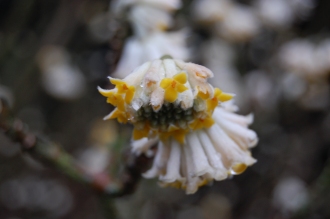Position: Full sun to dappled shade
Flowering period: Late winter to early spring
Soil: Moist, well drained
Eventual Height: 2.5m
Eventual Spread: 2.5m
Hardiness: 9a, 9b, 10a, 10b
Family: Thymelaeaceae
Edgeworthia chrysantha is a medium sized open, rounded, deciduous shrub. The dark green leaves are lanceolate, entire, up to 20cm long and 5cm wide, have fine hairs and are clustered at the ends of its branches. The branches are generally upright, are extremely flexible and are trichotomous (branching in threes). The bark is cinnamon colour. Its yellow fragrant flowers are tubular with white hairs on their exterior, they appear in clusters on spherical heads which are up to 5cm across. The fruits are purple and are often covered in the remains of the flower.
Edgeworthia chrysantha, commonly known as the Oriental Paperbush or Chinese Oriental Paperbush, is native to south west China and Nepal. Edgeworthia chrysantha is synonymous with Edgeworthia papyrifera. It was introduced into the UK in the mid 19th Century.
The etymological root of the binomial name Edgeworthia is named after Michael Pakenham Edgeworth (1812-1881), a Victorian amateur botanist. Chrysantha is derived from the Greek xrus ‘golden’ and enteron ‘guts’, i.e. the flower is golden on the inside.
The landscape architect may find Edgeworthia chrysantha useful for planting at the edge of an ornamental woodland or against a wall. It requires a sheltered position, including a north facing wall.
Ecologically, Edgeworthia chrysantha is a valuable source of nectar and pollen in the late winter months for bees and butterflies.
Edgeworthia chrysantha prefers moist, humus rich, well-drained soils. It tolerates most pH of soil. It will not tolerate dry or wet soils.
Edgeworthia chrysantha requires little maintenance.









One Response to “Edgeworthia chrysantha”